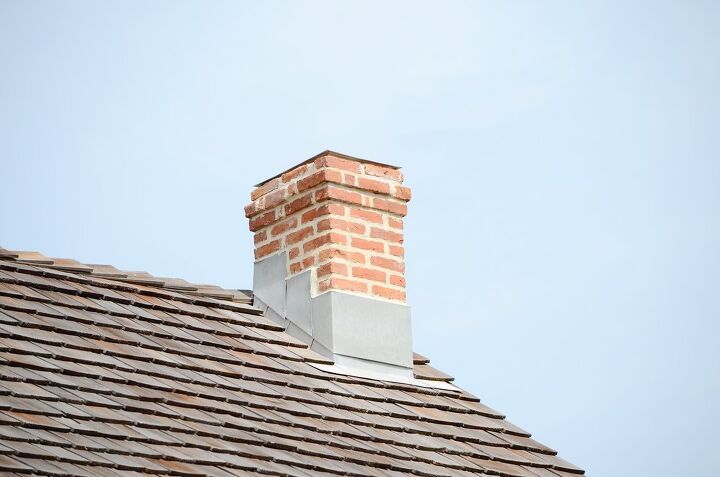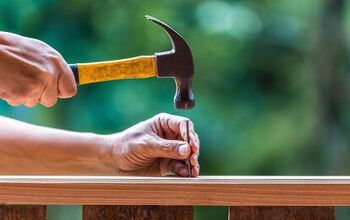What Are The Parts of a Chimney? (with Diagram)

Many homeowners are unaware of what makes up their chimney, as there is much more to it than a collection of bricks and a fireplace. Although you may never be quizzed on the parts of a chimney, they are still helpful to know.
In the winter months, your chimney and your fireplace are very important to the comfort of your home. A malfunctioning chimney could mean a risk to the safety of your home and the health of your family. While it is standard procedure to have your chimney inspected annually, issues could happen in between inspections.
Having a basic understanding of the chimney parts and their functions will help you to be able to identify problems easily when they arise. The parts of a chimney can be broken down into nine distinct categories: the bricks, the flue, the liner, the cap, the crown, chase cover, flashing, damper, and the smoke chamber.
Knowing the parts of a chimney will allow you to notice when an essential component becomes damaged or is no longer functioning. As a result, you will effectively save money, and protect your home and your family’s health by relaying this information to your chimney expert and tackling these problems sooner rather than later.
Do You Need Chimney or Fireplace Cleaning or Inspection?
Get free, zero-commitment quotes from pro contractors near you.

The Parts of a Chimney
There is much more to a chimney than meets the eye. While most are familiar with the fireplace, since it is where the fire takes place, this is just one piece of the puzzle. Aside from the actual fireplace inside your home, there are a number of additional components to your chimney that are vital to the performance and safety of your fireplace.
The following are some of the basic parts of a chimney that you should know:
- Bricks
- Flue
- Liner
- Cap
- Crown
- Chase Cover
- Flashing
- Damper
- Smoke Chamber
These nine components can be categorized further based on whether they are located inside or outside of the chimney. That said, let’s take a look at each part in detail to gain a better understanding of how both your chimney and your fireplace work.
Exterior Parts of a Chimney
1. The Bricks
While it’s very obvious that bricks are a part of a chimney, they serve a much more important purpose than you may think. Put simply, the bricks are the foundation of the chimney’s stack. When they’re not in optimal condition, your fireplace cannot perform appropriately and the safety of your home is put at risk.
When the brick and mortar of a chimney has weakened or become damaged, it allows moisture inside. As I’m sure you’re already aware, moisture in the home is never a good thing. Not only will subpar brick and mortar cause mold mildew to develop, it also impairs the structural integrity of your entire chimney.
2. The Crown
Sometimes referred to as the wash, a chimney crown is the slab of concrete at the top of the chimney that covers the bricks and mortar on a masonry chimney. Not to be confused with the cap, this component is not found on prefabricated or factory-built chimneys. Its purpose is to prevent water from seeping into the chimney system. The cap is what covers the rest of the opening where the smoke escapes.
It is absolutely essential to keep the crown of a chimney in good condition, as it is the primary barrier between your chimney and the outdoor elements. The crown also slopes down slightly on the side to prevent the build-up of rain or snow atop the chimney. If the crown becomes damaged in any way, it should be repaired or replaced as soon as possible.
3. The Cap
Chimney caps are an additional accessory that must be added to the chimney, as they typically do not come standard. It is never recommended to have a chimney without a cap. They are installed at the top of the chimney to keep outdoor elements from entering the home, such as:
- Snow
- Rain
- Sleet
- Debris (branches, leaves)
- Downdrafts
- Animals
Additionally, when the hot embers from the fireplace rise up the chimney, the wire mesh on the chimney cap acts as a spark guard to prevent fires from occurring on your roof.
4. Chimney Chase Covers
If instead of a masonry chimney you have one that is prefabricated or factory-built, it will come equipped with a chase cover. Located at the top, covering the opening of your chimney, the chase cover (or, chase top) serves the same purpose as a chimney crown.
Chase covers can be constructed from galvanized steel, stainless steel, copper, or aluminum. Copper and stainless steel are generally the most preferred options for chase covers, due to their durability and longevity. Aluminum chase covers are also a popular choice because of their wide range of color options, but aren’t as durable. Whereas, galvanized steel chase covers are considered a temporary option as they are susceptible to rust.
5. The Flashing
Also referred to as roof flashing, the flashing on a chimney is located in the area where the roof and the chimney meet. Made of vinyl, copper, steel, or aluminum, flashing is installed to protect the chimney, roof, and interior of the home from moisture and leaks. Just like most other parts of a chimney, it is important that the flashing is kept in good condition.
Flashing components tend to wear out quicker than other parts of the chimney. Because of this, the flashing should be inspected regularly. Something as simple as a rusted nail near the flashing could cause a roof leak and lead to extensive damage of your home.
Interior Parts of a Chimney
6. The Flue
Located in the interior of the chimney, the flue is the vertical shoot that combustion materials from the fires exit your home. Essentially, the flue is used to refer to the inside of a chimney. While they have various designs, they all have the same function of efficiently removing smoke from the firebox to the outdoors.
Although often confused with the liner, the chimney flue is different. Chimneys on older homes will generally only have the masonry bricks. However, nowadays, homeowners are required by law to line the flue.
Clay tiles are the most widely used flue liner installed in masonry fireplaces. They are long-lasting and the most economical choice. If you have a flue without a liner, the following chimney part is required, unless you have a metal chimney.
7. The Liner
The chimney liner is an absolutely crucial part of the chimney to ensure the safety of your home. Their purpose is to protect the combustible parts of a home from the intense temperatures that fires give off. Put simply, a chimney liner limits the fire to the chimney and keeps it from entering the rest of your home.
Liners are usually made of stainless steel, aluminum, or clay. Clay liners are the least durable, as they are typically the original lining of the flue. Aluminum liners are usually only used for gas fireplaces and stainless steel is often the ideal choice. Stainless steel liners are very versatile and can fit perfectly into your chimney.
When cracks start to develop in the liner, it must be replaced immediately. Even the smallest of cracks can create a fire hazard in your home. Always avoid using your fireplace until the liner is replaced.
8. The Damper
The damper, or throat damper, is the interior component that opens and closes your fireplace to the chimney. It is located inside the chimney, right above the firebox, and acts as a valve. When your fireplace is not in use, the damper should be closed to keep heated air inside and prevent drafts from entering your home.
When your fireplace is in use, the damper must be open to allow smoke to escape up the flue. Maintaining the damper and ensuring that it is functioning properly is very important to safe chimney and fireplace operation. When the damper stops working, it should be repaired or replaced before you can continue operating your fireplace as normal.
9. The Smoke Chamber
The smoke chamber is the part of a chimney that is located between the damper and the flue. This is where the smoke first enters before it escapes through the top of the chimney. It also compresses combustion byproducts so that it can exit the chimney, instead of reentering the home.
The smoke shelf, located inside the smoke chamber, is a flat section that collects debris or moisture that may have entered through the top of the chimney.
Smoke chambers have sloped walls to allow an easier path for the smoke to pass through on its way to the flue. This chimney component is very susceptible to being caked in soot and creosote. Therefore, it is very important that the smoke chamber is inspected and cleaned at least once a year.
The Parts of a Fireplace
In addition to the chimney, there are a number of components that make up a fireplace. These include:
- Firebox: This refers to the physical interior of the fireplace, where the fire is made, contained, and smoke is collected.
- Hearth: Built out of a fireproof material like stone or bricks, the hearth is the fireplace floor. Though, it actually extends past the fireplace.
- Surround: This component is responsible for protecting the walls around your fireplace. It is often topped with a decorative mantel.
- Mantel: What was once a smoke catcher in medieval times, the mantel is now a decorative frame that surrounds the fireplace. It is also where stockings are commonly hung during Christmas time.
- Fireplace Doors: These are an additional feature that serve as a protective barrier, and may be made out of metal or glass. They are designed to cut airflow when the fire dies down or when the fireplace is not in use.
For fireplaces that extend beneath the floor and into the basement, there is also an ash dump, ash pit, and cleanout door, which allow for convenient maintenance. The ash dump is an opening with a trap door that pushes all of the accumulated ashes from the fire into an ash pit underneath. Then, the cleanout door can be used to quickly and easily clean out the ashes. It is generally found behind the fireplace or outside of the home.
Some fireplaces may feature an entire fireplace insert, which are self-contained units that burn wood, gas, propane or wood pellets. These are generally metal boxes that are inserted into an existing masonry fireplace. They are designed to replace old, inefficient wood fireplaces with an upgraded, more efficient version that uses less fuel but produces more heat.
Do You Need Chimney or Fireplace Cleaning or Inspection?
Get free, zero-commitment quotes from pro contractors near you.

Wrapping It Up
Knowing all of the parts of a chimney and its functions can be a great tool for ensuring its safety and efficiency. Aside from understanding when these components may need maintenance, you will also be able to recognize problems when they arise and easily explain them to a chimney expert.
If you’re ever concerned that some of the parts of your chimney may not be functioning properly, it’s always recommended to get an expert opinion. In this case, don’t hesitate to reach out to a chimney sweep. They will be able to evaluate the performance and safety of your chimney and its components, and recommend a solution based on their assessment.

Jessica considers herself a home improvement and design enthusiast. She grew up surrounded by constant home improvement projects and owes most of what she knows to helping her dad renovate her childhood home. Being a Los Angeles resident, Jessica spends a lot of her time looking for her next DIY project and sharing her love for home design.
More by Jessica Stone




























